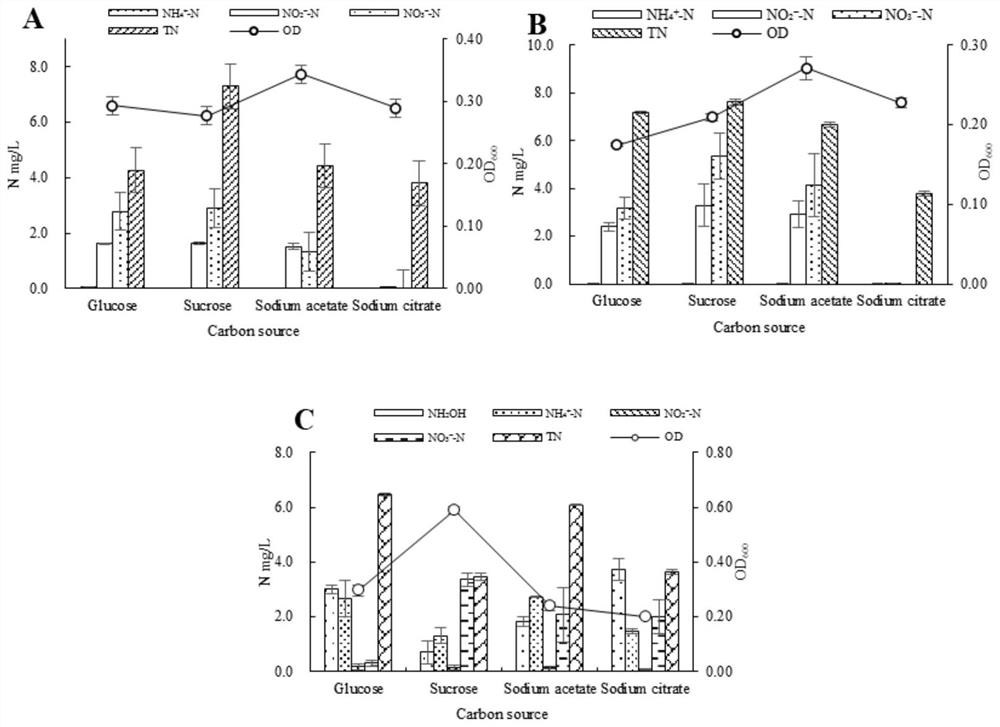Composite flora for regulating and controlling prawn culture water body
A technology of complex flora and prawns, applied in the direction of microorganism-based methods, applications, bacteria, etc., can solve the problem of no uniform standard for safety evaluation, achieve the effect of improving the ability of resisting pathogenic Vibrio and improving the treatment effect
- Summary
- Abstract
- Description
- Claims
- Application Information
AI Technical Summary
Problems solved by technology
Method used
Image
Examples
Embodiment 1
[0025] Example 1: Screening for Halomonas alkalophilus AC3-2 strain, Halomonas rugeria BD15-5 strain and Halomonas beautifula BD15-8
[0026] 1) Screening sample source and screening medium
[0027] In September 2017, the shrimp biofloc culture system obtained from Weihai Wendeng Taiyu Aquatic Breeding Co., Ltd. was sampled and analyzed (salinity was 30‰). The biofloc was made of bagasse, rice husk powder and Bacillus as components , which is cultivated by the floc generation device in the culture system, can effectively provide the water treatment effect of cultured prawns, and the prawns will not produce stress response.
[0028] Under sterile conditions, take 0.2 mL and spread it on a solid LB plate, store it at 4°C, and bring it back to the laboratory.
[0029] The composition ratio of the medium used in the screening process is as follows:
[0030] Enrichment medium: NaNO 2 1g, CH 3 COONa 4.8g, filtered seawater 1L, pH 7.5;
[0031] Screening medium: NaNO 2 1g, CH...
Embodiment 2
[0049] Embodiment 2: the physicochemical property of bacterial strain
[0050] Strain AC3-2 Gram-negative, non-spore-shaped, rod-shaped, fusiform, straight or curved. After the LB solid medium was cultured in a constant temperature incubator at 28°C for 24 hours, the appearance of the colony was as follows: the colony was a small round shape, milky yellow opaque, with neat edges and a smooth surface ( figure 2 ) strain's growth temperature range is 20240°C, the optimum temperature is 37°C; the growth pH range is 729, the optimum pH value is 8;
[0051] Strain BD15-8 Gram-negative, non-spore-shaped, rod-shaped, fusiform, straight or curved. After the LB solid medium was cultured in a constant temperature incubator at 28°C for 24 hours, the appearance of the colony was as follows: the colony was round, with a raised center, neat edges, smooth surface, milky yellow opaque ( figure 2 ). The growth temperature range of the strain is 22242°C, the optimum temperature is 37°C; th...
Embodiment 3
[0053] Embodiment 3: the nitrogen-reducing performance of three bacterial strains
[0054] 1) Effect of carbon source on strain growth and degradation performance
[0055] Both AC3-2 and BD15-8 strains can grow with glucose, sucrose, sodium acetate and sodium citrate as the sole carbon source. When sodium acetate was the sole carbon source, the OD of strains AC3-2 and BD15-8 600 When sodium citrate was used as the sole carbon source, strains AC3-2 and BD15-8 had the highest removal rate of nitrite nitrogen (both 100%), the highest removal rate of total nitrogen, and no nitrate nitrogen and total ammonia state Nitrogen accumulation ( image 3 A and image 3 B).
[0056] When the strain BD15-5 used sucrose and sodium citrate as the sole carbon source, the removal rates of total ammoniacal nitrogen were 84.6% and 83.1%, and the removal rates of total nitrogen were 65.4% and 63.7%. The accumulation of hydroxylamine is only 0.7mg / L ( image 3 C). Therefore, sucrose is the opt...
PUM
| Property | Measurement | Unit |
|---|---|---|
| body length | aaaaa | aaaaa |
| weight | aaaaa | aaaaa |
Abstract
Description
Claims
Application Information
 Login to View More
Login to View More - R&D
- Intellectual Property
- Life Sciences
- Materials
- Tech Scout
- Unparalleled Data Quality
- Higher Quality Content
- 60% Fewer Hallucinations
Browse by: Latest US Patents, China's latest patents, Technical Efficacy Thesaurus, Application Domain, Technology Topic, Popular Technical Reports.
© 2025 PatSnap. All rights reserved.Legal|Privacy policy|Modern Slavery Act Transparency Statement|Sitemap|About US| Contact US: help@patsnap.com



